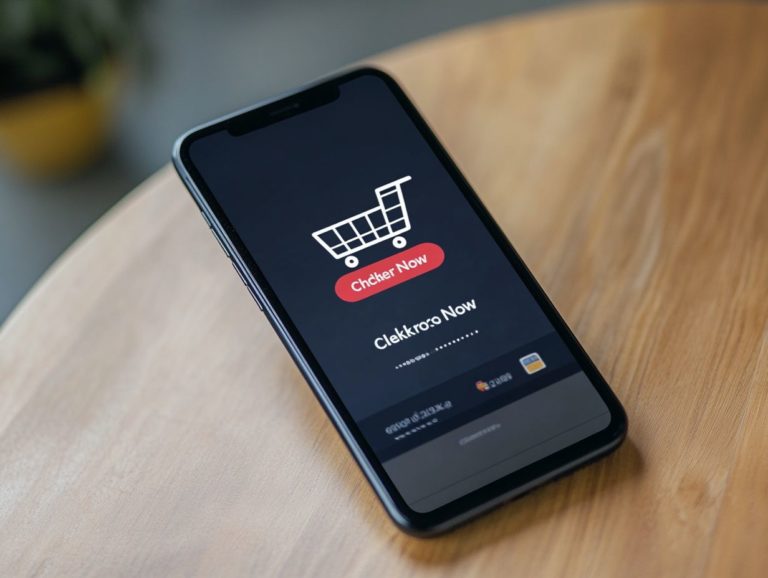How to Align Content with User Intent
In today’s digital landscape, grasping user intent is essential for crafting content that truly resonates. When users are hunting for information, exploring a site, or poised to make a purchase, aligning your content with their intent can significantly boost engagement and conversion rates.
This article delves into the various types of user intent, offers strategies for customizing your content, and presents tips on optimization and measuring success. Discover the keys to establishing a more meaningful connection with your audience.
Contents
- Key Takeaways:
- Understanding User Intent
- Types of User Intent
- Creating Content for User Intent
- Optimizing Content for User Intent
- Measuring Success with User Intent
- Frequently Asked Questions
- 1. What is User Intent and why is it important for content alignment?
- 2. How can I determine the User Intent for my target audience?
- 3. What are some common User Intent categories and how can I align my content with them?
- 4. Can I use keywords to align my content with User Intent?
- 5. Is it important to constantly review and update my content to align with changing User Intent?
- 6. How can I measure the success of aligning my content with User Intent?
Key Takeaways:

- Target your content to match user intent by understanding their needs and goals.
- Optimize your content with keywords and structure to provide valuable information and meet user intent.
- Measure success with metrics that track user intent, such as click-through rates and time spent on page.
Understanding User Intent
Understanding user intent is vital for crafting a successful content strategy, particularly in the competitive landscape of digital marketing. Accurately aligning your content with user needs can markedly improve your visibility on search engines like Google.
Recognizing different types of search intent helps you improve your search engine optimization (SEO) efforts and meet your audience’s expectations. This approach ensures that your content not only achieves high rankings but also provides high-quality results that effectively engage users.
Defining User Intent and Its Importance
User intent is all about understanding the purpose behind a search query. It’s crucial for shaping effective SEO strategies and crafting high-quality content that resonates with your audience.
By tailoring your strategies to meet the specific needs of your target demographic, you can boost user engagement. For example, if someone searches for “best budget laptops,” their intent is likely to uncover affordable options. Your content should focus on product comparisons, pricing, and overall value for money.
Understanding user intent gives you a competitive edge! By analyzing the keywords your competitors target, you can identify gaps in the market. This insight enables you to optimize your content effectively across search engines, ensuring it remains relevant and improves your rankings.
Types of User Intent
User intent falls into three primary categories: informational intent, navigational intent, and transactional intent. Each type serves unique needs throughout the user s journey, significantly shaping your content strategy in response.
Understanding these distinctions helps you tailor your approach and effectively engage with your audience.
Informational intent refers to searches aimed at acquiring knowledge, while navigational intent is about locating a specific website or page. On the other hand, transactional intent focuses on completing a purchase or action.
These categories hold significant importance for marketers and content creators, reflecting the diverse motivations driving user queries. For instance, when someone searches for “how to bake a cake,” they’re displaying informational intent and seeking recipes or tips. Conversely, a user typing “Facebook login,” clearly demonstrates navigational intent, eager to access a specific site. Meanwhile, someone searching for “buy running shoes online” is exhibiting transactional intent, signaling their readiness to make a purchase.
By grasping these distinct intents, businesses can refine their content strategies to meet users’ expectations effectively, ultimately boosting engagement and conversion rates.
Creating Content for User Intent

Creating content that resonates with user intent demands a strategic approach. You need to understand your target audience and interpret their needs precisely, employing keyword research and analyzing search queries.
This understanding is crucial for delivering high-quality content that meets their expectations and drives engagement. Start optimizing your content today!
Identifying Target Audience and Their Intent
Identifying your target audience and understanding their intent is crucial for successful SEO. This knowledge gives you the power to tailor your content precisely to meet the specific needs and interests of your users.
Leveraging tools like SEMrush can greatly enhance this identification process. You can analyze competitor information and glean insights into what truly resonates with your audience.
By analyzing search queries and user behavior, you can uncover recurring themes and interests that will shape your content strategy. For example, diving into keywords and the questions users frequently ask can illuminate the specific information they are actively seeking.
This alignment boosts engagement and drives organic traffic, forging a connection that fulfills your audience’s needs while contributing to your overall SEO success.
Using Keywords and Search Queries
Incorporating the right keywords and understanding search queries is essential for aligning your content with user intent. This significantly enhances the effectiveness of your SEO strategy.
To achieve this, you must delve into various techniques for effective keyword research. This includes analyzing your competitors keywords and utilizing powerful keyword tools that reveal insights on search volume and trends.
Exploring long-tail keywords phrases that are more specific and usually longer than standard keywords might present lower competition while offering greater relevance. By examining user queries, you can uncover the motivations behind those searches, enabling you to create content that directly addresses specific needs.
Consistently refining your keyword strategy based on user intent not only maximizes your visibility on search engines but also cultivates a deeper connection with your audience, ensuring your content resonates and informs with precision.
Optimizing Content for User Intent
Optimizing content for user intent means carefully crafting both the structure and the delivery to align seamlessly with what users are actively seeking. By doing so, you ensure that your content not only meets their needs but also delivers the relevant results they desire on search engine results pages (SERPs), which display the results of search queries.
Structuring Content and Using Visual Aids
Structuring your content effectively and incorporating visual aids can greatly enhance user engagement. This ensures that it aligns with user intent and improves overall readability.
To achieve this, utilize headers to break down sections, creating a clear hierarchy that enables readers to scan your content effortlessly. Implementing lists and bullet points not only summarizes critical information but also makes the text more digestible.
By strategically placing images and infographics, you can further enrich the written material. This caters to visual learners and reinforces key messages. This multifaceted approach supports diverse learning styles and keeps your audience intrigued, encouraging them to interact with your content for a longer duration.
These methods create a more interactive and enjoyable reading experience, making your content truly stand out.
Providing Relevant and Valuable Information

Providing relevant and valuable information in your content is crucial for addressing user intent effectively. This guarantees users find what they’re excited to discover, significantly enhancing their overall experience.
By understanding the specific queries and concerns of your audience, you can tailor your messaging to align seamlessly with their needs. For example, a fitness brand could craft a comprehensive guide on home workouts specifically designed for beginners eager to discover simple yet effective exercises.
Incorporating strategies such as user-generated content or testimonials can offer authentic insights that foster trust. When users feel their questions are answered and their concerns acknowledged, they are much more likely to engage, share, and convert. This ultimately helps establish a loyal customer base and drives sustainable growth for your brand.
Measuring Success with User Intent
Measuring success through user intent requires you to analyze a range of metrics that reveal how effectively your content aligns with user expectations. It s essential to assess how well it meets their needs within the framework of a comprehensive content strategy.
Metrics to Track and Analyze
To optimize your SEO strategies, track and analyze user intent metrics. This helps refine your content to meet your audience’s needs.
Examine your click-through rates. This shows how well your content grabs visitors’ attention from the start.
Check the time users spend on your page. This indicates how engaging your content is and if it meets their expectations.
Your organic search rankings reflect your visibility in search results. Understanding these metrics through user intent offers insights into what your audience is searching for.
Continuously optimizing your content ensures it resonates with their interests and aligns with their search behavior.
Frequently Asked Questions
1. What is User Intent and why is it important for content alignment?
User Intent is the goal a user has when searching or interacting with content. It is vital for ensuring the content addresses user needs and provides relevant information.
2. How can I determine the User Intent for my target audience?
Determine User Intent by analyzing search queries and conducting surveys or interviews. Insights from website analytics and social media can also help.

3. What are some common User Intent categories and how can I align my content with them?
Common User Intent categories include informational, navigational, and transactional. Align your content by providing valuable information, helping users find resources, and encouraging specific actions.
4. Can I use keywords to align my content with User Intent?
Yes, use keywords to align your content with User Intent. Conduct keyword research to identify terms your audience uses, and incorporate them naturally.
5. Is it important to constantly review and update my content to align with changing User Intent?
Yes, regularly review and update your content to stay aligned with User Intent. User needs and behaviors change, so keeping your content current will enhance its relevance.
6. How can I measure the success of aligning my content with User Intent?
Track metrics like website traffic, time on page, and conversion rates. Gather feedback through surveys or comments to see if your content meets user needs.






